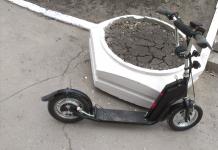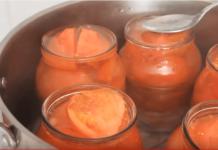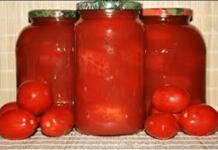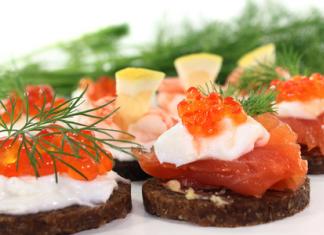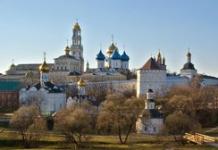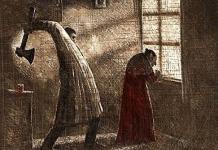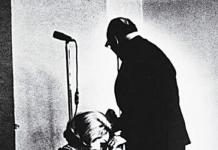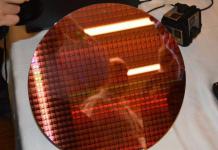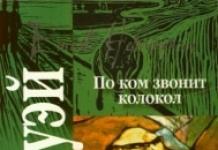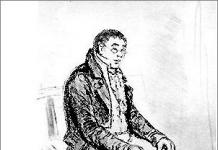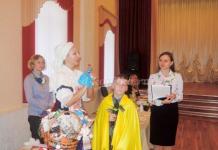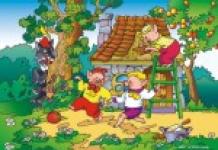There are so many regions in Russia that poorly educated young people sometimes get dizzy, and they confuse Moldova with Mordovia. At the federal level, there is no big news from Saransk and the surrounding area, so the population knows little about such a wonderful region.
Some have heard of Mordovia only in the translations of Goblin (a well-known translator of foreign films). In the goblin translation of The Lord of the Rings, Mordor was called Mordovia. It must be admitted that Mordovia became synonymous with Godforsakenness long before the first translations of the Goblin. For example, in the book of the famous writer Dovlatov "Branch", the wife says to her husband, who admires a coffee vending machine: "You are not in Mordovia, scarecrow!" And if we add to these images the Soviet GULAG, which had an extensive representation in Mordovia, then it is not at all surprising that the people consider this region to be something distant, cold, wild and frightening. But in fact, Saransk is just a stone's throw from Moscow, and Saransk itself is the sweetest city. In 2011, he even won a competition for the most comfortable city in Russia. Of course, we know how these competitions are held, but all the same. The city is really well maintained.
Saransk. Photo by naum-lidiya (http://fotki.yandex.ru/users/naum-lidiya)
Little was known about Mordovia even in Soviet times... The only thing that added fame to the region was a well-known anecdote:
"In the Supreme Council Soviet Union the question of the unification of the Jewish Autonomous Region and Mordovia was heard. It was decided in the end not to unite them, since the disputing parties did not come to consensus about the name new republic: one side proposed to name Zhido-Mordovskaya, and the second - Morda Zhidovskaya ... "(The editors of the project are neither Semites, let alone anti-Semites. Nobody needs to be offended. This is our folklore. This is our story.)
Let's go back to the region. As already mentioned, the first thing Mordovia is known for is its camps. Let me quote Dovlatov again:
“The ceremonial part lasted only twenty minutes. The manager himself spoke the longest. In the end, he said: - We will forever remain prisoners of fascism. After all, what we have experienced is not forgotten ...
"Is he also a prisoner of war?" - I asked the armless Gurchenko.
“This bloke from the theater,” the old man replied, “appointed him as a party committee. For the fourth year he performs here ... In Mordovia, he would be three years old ... For felling ... "
The camps in Mordovia are located mainly in the western part of the republic. As you know, the Soviet government is very vindictive. At one time, Mordovia tried to resist young revolutionaries, and as a punishment, the region was awarded a large number of camps. In those years, the communists suppressed the Mordovian uprisings with the help of chemical weapons.
Now only memory and history remind of those terrible times. The current government in the republic is in excellent relations with United Russia and Putin. In all elections there is a good turnout and abundant support from United Russia. On the territory of the republic there is a pretentious monument "Forever with Russia".
Until 2012, everything in the region was controlled by Governor Merkushkin. In fact, the entire republic was his principality. He led the region for 17 years, and during this time he managed to place the people he needed in key posts, and successfully set up all the processes in the republic for himself. Local residents say that not so long ago Merkushkin could have been imprisoned, but he found a compromise with the country's leadership, and began to develop sports in the region with his own money. So far, no great success has been achieved on this basis. True, a large hockey stadium was built in the republic, but the game with the puck is not yet very developed, there are no corresponding traditions and a good school.
A lot of money was invested in the football team of Mordovia, which from the second division of domestic football reached the Premier League, but the Saransk footballers did not manage to stay there. The flow of money to the team has slightly decreased, and that's it, a fiasco. And all why? There are no traditions and a strong sports school. Money is invested - sportsmen-shabashniki come. No money - no athletes - no victories.
The regional leadership is well characterized by the situation with the football stadium in Saransk. Until 2010, in the city, the local team played at the normal Svetotekhnika stadium, which could accommodate 14,000 people, but it was suddenly demolished in order to break up the square in this place. Svetotekhnika was replaced by the Start stadium, which accommodated only 5.3 seats. Is there logic? There is no logic. When the Svetotekhnika was demolished, they officially announced that they would build a stadium for 30 thousand seats in Mordovia to replace it, but the promises have not come true yet.
Stadium Start. Photo by pe100v (http://fotki.yandex.ru/users/pe100v)
In 2018, during the World Cup, Saransk is to become one of the host cities of the competition. At the "Start" no one will allow the World Cup games to be held, so the regional authorities will have to invest and build a new stadium with a capacity of 44 thousand spectators. Who will need it after the end of the championship is unknown. Local "Mordovia", which now plays in the second most important Russian league, will gather full stands only if it will distribute beer for free during matches, or show a striptease during the break.
Talking about distinctive features Mordovia, one cannot fail to mention the interesting situation with the anniversaries of the region. In 2012, Saransk celebrated the thousandth anniversary of the annexation of Mordovia to Russia. It is curious that this date was already celebrated in 2006, and 500 years - in the eighties. Time flies so quickly in this wonderful land.
However, despite all the oddities and curiosities, Mordovia is a convenient region for life, and its capital is one of the best cities in Russia.
Geographical position
Mordovia is located in the eastern part of the East European Plain, approximately halfway between Moscow and the Volga. Part of the republic is located on the Volga Upland, and part - on the Oka-Don Plain. The highest point of Mordovia rises 324 meters. In the south, the region borders on the Penza region, in the west - with Ryazan region, in the northeast, the neighbor is Chuvashia, in the east - Ulyanovsk region, and in the north - the Nizhny Novgorod region.
It should be noted that Mordovia is the closest Russian republic to Moscow: from the Moscow Ring Road to the western border of Mordovia along the road - 398 km, and if you fly directly by helicopter, then 330 km. However, despite its proximity to the capital, Mordovia belongs to the Volga Federal District, and not to the Central.
Population
The indigenous population of Mordovia is Mordva, which is divided into two nations: Moksha and Erzya. There is also a Shoksha dialect in the Erzya language. True, this is an almost extinct language, no one speaks it. There are also dialects of Karatay and Teryukhan. Teryukhansky is a mixture of Tatar and Erzya languages.
Russians in Mordovia are about a little more than half of the total population, and therefore the Russian language is in use there. The indigenous Mordovian youth prefers to speak Russian and do not know their languages well. It is very difficult to distinguish outwardly a Mordvin from a Russian, we have all mixed up for a long time.
In other regions of Russia, visitors from Mordovia can give out a characteristic accent - they stretch the vowels at the end of a word, pronounce words in a chant and can put several stresses in one word. In addition, in Mordovian languages, nouns have no gender, and therefore native speakers often make mistakes in Russian: “I bought a cat, but he eats badly”. True, this applies mainly to the older generation, young people speak a typical Russian language.
Saranskaya embankment. Photo by or-lyuba (http://fotki.yandex.ru/users/or-lyuba/)
In addition to the speech of a real Mordvin, a surname can give out - in it the root of an incomprehensible meaning is combined with the suffix -kin, so the surname sounds funny and rustic. For example, Kaniskin. What is "canis" - one Mordovian knows. There are also surnames ending in –ev, which are derived from ancient Mordovian names. For example, Gundyaev. By the way, the name Gundyaev is borne by Patriarch Kirill, who in the world is Vladimir Gundyaev, the real Erzya.
Mordovians in Mordovia are about 40%. Russians are about 53%, there are still 5% Tatars. Many Mordovians can be found in Moscow. It is close to go from Saransk to the First See, and young people, at the first opportunity, try to go to the capital. There are quite a lot of cars with Mordovian numbers in Moscow.
Crime
Now it is calm in Mordovia, because there is nothing to divide in the republic. There are really no huge industries and minerals. However, in the 90s, things were different. In the organized crime group, fighters from Mordovia were highly valued. Local young people left in batches for Moscow to join one or another group. Mordovians were valued for their excellent physical shape, fearlessness and thirst for money. There was no work at all in Saransk and its environs in those years.
Unemployment rate
Mordovia was not lucky with minerals. There are oil reserves in Saransk itself, but it is not being produced. Either the reserves are small, or it is expensive to mine.
The main industrial sectors in the region are lighting and electrical engineering, mechanical engineering and metalworking, the production of medicines, and the food industry. In the 90s, Lisma, which produced a wide range of light sources, was almost bent, but the state helped it. Now the plant has become a state unitary enterprise, and at the very least managed to provide it with orders.
One of Lisma's workshops. Photo by proviandrey (http://fotki.yandex.ru/users/proviandrej/)
There is in Mordovia JSC "Plant" Saranskkabel ", JSC" Biochemist ", which produces antibiotics, and other enterprises. There are no particular problems with working in the region. True, some villages have not yet recovered from the long years of devastation, but this is observed everywhere in the country. The average salary in the republic is 21,000 rubles. To many, this amount seems small, and therefore people, especially young people, are trying to leave for Moscow. Night on the train - and you are in the capital, and there are completely different earnings.
Property value
Real estate in Mordovia is not cheap. The average price per square meter in Saransk is over 50 thousand rubles. In Ruzayevka, real estate is much cheaper. For 2 million you can rent a good two-room apartment there. In Saransk, this will require 500-600 thousand more.
Climate
The climate in Mordovia is temperate continental. The average temperature in January is -10 ° C, and in July +20 ° C. Living here is quite comfortable. True, due to the lack of relief, the weather can change dramatically. The northern air masses are replaced by southern ones, and vice versa.
Cities of the Republic of Mordovia
Park zone of Saransk. Photo by or-lyuba (http://fotki.yandex.ru/users/or-lyuba/)
Ruzayevka- the second city of Mordovia in terms of population, industry and everything. The population of Ruzayevka is only 46 thousand people. And, in truth, the city resembles rather big village than a small town. He even has a village name, Ruzaevka, and not some, for example, Ruzaevsk. The city is an important railway junction. Besides, on the railroad, local residents can work at the Ruzkhimmash plant, Vismut, Ruztex and others. In principle, there is enough work here, but young people still try to leave.
In the XI-XIII centuries. for control over the lands of the Mordovians, the rulers of the Volga-Kama Bulgaria and the Russian princes fought. In the XII-XIII centuries. new Mordovian settlements appeared ("firmaments", according to Russian chronicles) with powerful fortifications (Vindreyskoe, Fedorovskoe). Among the population, a category of professional warriors with equestrian equipment, shields, etc. stood out. Under the conditions of the growing external threat, a large military alliance of the Mordovian tribes was formed and on its basis - an early state association (according to the Hungarian missionary Julian of the middle of the 13th century - the "kingdom of the Mordvans"). One of its divisions was the "Purgas volost" mentioned in the Russian chronicle, headed by Purgas. According to researchers, "Purgasov volost" occupied the interfluve of the Moksha and Tyoshi rivers, where numerous Mordovian settlements were located (including the Sarov settlement - a large craft and trade and, apparently, a political center). Archaeological data indicate an influx of mainly Erzya and Moksha populations to these lands, which indicates the ethnic consolidation of the Mordovian people. In the 1220-1230s. the Vladimir princes made several trips to the territory of modern Mordovia, the most significant of them - to the "Purgas volost" (1228). Another Mordovian formation developed in the upper and middle Primokshan area. Some researchers believe that it was headed by Puresh. On the southern borderlands of the Mordovians (the territory of the modern Penza region), settlements were located - strong points on the trade route from Volga-Kama Bulgaria to Kiev (Zolotarevskoe, Yulovskoe, etc.).
Political and economic development the Mordovian people was interrupted by the Mongol-Tatar invasion. The first blow to the Mordovian lands was struck in 1237, in 1239 they were again subjected to ruin; finally the Mordovians were conquered in 1242.
In the middle of the XIII - the middle of the XV century. a significant part of the modern territory of Mordovia was part of the Golden Horde. At the beginning of the XIV century. here a large administrative center of the Horde arose - the city of Mokhshi, in which its own coin was minted since 1313. The settlements of the local feudal nobility were usually located near large rivers in high, inaccessible places. On one of them, the Ityakovsky settlement, a bronze plaque was found, issued to officials by the Golden Horde administration. In the second half of the XIV century, during the period of civil strife in the Golden Horde, some Horde princes tried to found independent uluses on the territory of modern Mordovia: on Moksha - Tagay, in the Sur region - Segiz-bey, in Primokshanye - Bekhan, etc. After Timur's campaigns at the end of the XIV century. Mokhshi lost its significance as an outpost of the khan's power. From the middle of the 15th century. after the collapse of the Golden Horde, these territories became part of the Kazan Khanate.
In the 1480s. a significant part of the Mordovian lands was already part of the Russian state. In connection with the aggravation of relations with the Kazan Khanate and the frequent raids of the Nogai biys and Crimean khans, the rulers strengthened the eastern borders. To this end, the construction of new fortified cities began on the Mordovian outskirts. The Kazan campaigns were undertaken against the Kazan Khanate, as a result of which in 1552 it was annexed to the Russian state (about 10 thousand Mordovian warriors took part in the campaign).
After 1552, a system of all-Russian provincial administration was introduced in the region, which incorporated military, administrative and judicial functions. The participation of the local nobility as volost centurions, Pentecostals was allowed. In some cases, special officials were appointed to control the Mordovians - "Mordovian heads", clerks, etc. Finally, the system of voivodship management was formed during the construction of notch lines (Shatsk - Kadom - Temnikov - Alatyr - the second half of the 16th century; Insar - Atemar - Saransk - Troitsky prison - 40s of the 17th century), which contributed to the strengthening of centralization in the region local government. The voivode was entrusted with the task of building fortresses and markings; they had all the power in the region. Russian settlements appeared on the lands granted to the nobles for their service on the serif line. Local land tenure developed, while land plots and population grew. Mordovian and Tatar princes were attracted to the military, border guard service, to participate in administrative management, for which they received land and monetary rewards.
During the Time of Troubles, the Mordovian Territory provided significant support to the 2nd militia. In the summer of 1612, the Mordovian Murza Bayush, leading a detachment of Alatyr Murzas, Mordovians and servicemen, opposed the Crimean and Nogai Tatars, who broke through the guard lines near the river. Alatyr and moved to Arzamas and Nizhny Novgorod. Having won the battle with the village. Chukaly and in the Ardatovsky forest, the detachment saved the rear of the militia.
2nd half of the 17th century characterized by the expansion of local and patrimonial land tenure as a result of the mass distribution of estates from state funds and through the unauthorized seizure of land from the Mordovian peasants by landowners. In the years 1661-1700. in Penza, Insarsky, Temnikovsky districts they were given 75% of the land from its total amount. The lands on the territory of modern Mordovia were received by the princes Golitsyns, Romodanovs, Trubetskoy, noble families of the Naryshkins and others. Mordovia was engaged in carriage, trade, logging, tar-smoking. Carpentry, coal burning, mill, tanning, cooper and other trades, trade in agricultural and livestock products, honey, wax, furs, and fish were developed.
In 1708, Peter I carried out a provincial reform, according to which the Mordovian Territory was divided between Kazan (Temnikov) and Azov (Saransk, Krasnaya Sloboda, Insar, Troitsk, Atemar, Shishkeevo) provinces. In 1719 the provinces were divided into provinces and counties. The Azov province included Insarsky (3rd province), Temnikovsky, Kadomsky and Krasnoslobodsky districts (4th); in the Kazan province - Saransk district (3rd province). The newly formed Nizhny Novgorod province included the lands of Arzamas (2nd province) and Alatyr (3rd) counties. In 1725, the Azov province was transformed into the Voronezh province, which included Insarsky from the Tambov province, and Temnikovsky and Krasnoslobodsky districts from Shatsky. The provincial reform of Catherine II (1775) also introduced changes in the administrative-territorial division of the Mordovian region. It ended up in the Tambov governorship (Temnikovsky, Spassky districts), Nizhny Novgorod (Lukoyanovsky, Sergachsky districts), Simbirsky (Ardatovsky district), Penza (Krasnoslobodsky, Insarsky, Saransky districts). In 1796 the governorships were transformed into provinces. By the decree of Paul I (1797), the Penza province was liquidated, the Saransk district was transferred to the Simbirsk province, and Krasnoslobodsky and Insarsky to the Tambov province. In 1801 the Penza province was restored in its former composition. Throughout the XIX century. the administrative-territorial division of the Mordovian region did not change. Its lands belonged to Penza (Krasnoslobodsky, Insarsky, Saransky districts), Simbirskaya (Ardatovsky, part of Karsunsky), Nizhny Novgorod (part of Lukoyanovsky, Sergachsky) and Tambov (Temnikovsky, part of Spassky) provinces. In 1917-1918. Ruzaevsky district was separated from the structure of the Insar district.
In 1717, the territory of modern Mordovia was devastated during the Great Kuban pogrom, which became the last raid of nomads into the region. In the 2nd half of the 18th - early 19th century. in the Mordovian environment, Orthodoxy was entrenched, becoming an integral part of the way of life.
In the XVIII century. potash production, distillation (1.5 million buckets of wine per year) achieved significant development, large state distilleries - Brilovsky and Shtyrmensky operated, small metallurgical enterprises functioned (Ryabkinsky, Sivinsky, Vindreisky, Insarsky plants, etc.). In the 1st half of the 19th century. the state Troitsko-Ostrog distillery, the Augur metallurgical plant of ND Manukhina arose. V late XIX- the beginning of the XX century. the timber industry developed rapidly. Its main centers were concentrated in the Spassky and Temnikovsky districts, rich in forests. The development of the timber industry was stimulated by the construction of the Moscow-Kazan railway on the territory of modern Mordovia (1893-1902).
The first representatives of the Mordovian intelligentsia appeared, mostly rural teachers. In 1905 he began his creative way one of the founders of Mordovian literature - ZF Dorofeev. In 1906, the publisher of the first newspaper of the region "Muzhik" VV Bazhanov, the sculptor SD Erzya, the public figure and prose writer SV Anikin, and the teacher GK Ulyanov announced themselves.
In late 1917 - early 1918, Soviet power was established on the territory of modern Mordovia. In 1918 and 1919. the Mordovian counties were the front line, the closest rear of the Eastern Front of the Red Army during Civil War 1917-1922; in April - May 1919, the Bashkir Revolutionary Committee was located in Saransk. The actions of food detachments and commissaries became the reason for peasant riots in the spring - summer of 1918, unrest and uprisings of peasants in the villages of Bolshaya Azyas, Yakovshchina, Barancheevka, Lada, Pyatina, Gumny, Staraye Sindrovo, etc. ... Major uprisings took place in the region in 1919. Along with peasant uprisings, there were performances in military units, and deserters became participants in the uprisings. By 1920, desertion in the province had grown into a "green movement". A difficult situation arose on the territory of modern Mordovia during the Tambov uprising of 1920-1921. under the leadership of A. Antonov. Temnikovsky and Krasnoslobodsky districts were declared under martial law, a tense situation arose in Ardatovsky, Karsunsky, Saransky, Insar and Spassky districts. In 1921-1922. the region was struck by famine, accompanied by outbreaks of typhoid, malaria, etc.
In 1926, the Mordovian counties became leaders in terms of gross output Agriculture in the Middle Volga region, and by 1928 the restoration of agriculture was completed. The restoration of industry proceeded slowly and unevenly, many enterprises in the region were closed (including the iron foundry and sawmill in Zubovaya Polyana, the Sivinsky iron-making plant, the Temnikovskaya faience factory, etc.). At the same time, in the 1920s-1930s. a cannery, a cotton plant, a hemp plant in Saransk, and a machine-building plant in Sarov were built.
On July 16, 1928, the Mordovian Okrug with the center in the city of Saransk was formed as part of the Middle Volga Region. On January 10, 1930, the Mordovian District was transformed into the Mordovian Autonomous Region, on December 20, 1934, into the Mordovian Autonomous Soviet Socialist Republic.
In the late 1920s - early 1930s. in the economy of Mordovia, prison labor began to be actively used. The main areas of their economic activity were logging, sawmilling and railway construction. The largest camp of the GULAG system on the territory of Mordovia was the Temnikovsky ITL (Temlag, administration in the village of Yavas), created in 1931 (in 1948-1954 - Special Camp No. 3, or Dubravlag). By the early 1940s. Mordovia was one of the main producers in the Volga region of cottonin, ropes and ropes; the textile, food, processing, logging and woodworking industries developed.
To the Great World War II on the territory of Mordovia, units of the 6th engineer army, 9 divisions, 3 regiments, 5 battalions, a special division of armored trains, 7 air units, the 178th department of the communications battalion, etc. were deployed, 14 hospitals were also located here (including 6 in Saransk ). On the territory of Mordovia, the 326th Roslavl Rifle Division was formed, at the expense of the population, a link of combat aircraft and a tank column "Mordovian Collective Farmer" were built. In 1941, equipment of 17 enterprises from the Ukrainian SSR, the BSSR, as well as the Bryansk, Kursk, Oryol regions and others was evacuated to Mordovia. Thanks to the commissioning of the Saransk mechanical plant and the Elektrovypryamitel plant, the foundation was laid for the post-war development of large-scale industry in Mordovia. The republic received about 80 thousand people of the evacuated population (including 25 thousand children under 15 years old).
In the spring of 1946, drought seized Mordovia, which led to famine. The industry was gradually developing: the placement of a complex of enterprises of the chemical and lighting industries, a foundry, the expansion of the construction base (the Kovylkino plant of silicate brick and slate in the working village of Komsomolsky), an instrument-making plant began, the cable, tool and other factories were reconstructed, 1- I turbine of Saransk CHPP-2, workshop of dump truck plant, macaroni and furniture factories. By the mid-1960s. Mordovia has turned from an agrarian-industrial region into an industrial-agrarian one. Industrial development was facilitated by the Saratov-Gorky gas pipeline (1959-1960) running through its territory.
In the second half of the 1980s - the first half of the 1990s. in Mordovia, social forces have become more active in defense of national languages, culture, and the identity of the Mordovian people; 3 congresses of the Mordovian people were held (1992, 1995, 1999), a number of public organizations arose, such as the Council for the Revival of the Mordovian People (1992), the Foundation for the Salvation of the Erzyan Language named after I. A.P. Ryabova (1993) and others.
On December 7, 1990, at the session of the Supreme Soviet of the Mordovian ASSR, the Declaration on the state and legal status of the republic was adopted, the Mordovian ASSR was transformed into the Mordovian SSR. On December 25, 1991, the post of President was established, and V.D. Guslyannikov was elected to this post. On April 7, 1993, the Supreme Soviet of the MSSR abolished this post. On January 25, 1994, the Mordovian SSR was renamed the Republic of Mordovia. On September 21, 1995, the Constitution of the Republic of Mordovia was adopted, a new system of government bodies was approved. On September 22, 1995 N.I. 2005, in 2010 he was approved as the Head of the Republic for another term). On May 14, 2012, at the seventh session of the State Assembly of the fifth convocation, V.D.Volkov was approved as the Head of the Republic of Mordovia.
The transition to market relations in the 1st half of the 1990s. led to a decrease in the level of socio-economic development of the republic. Only since 1997 in Mordovia there has been a tendency for the growth of industrial production based on restructuring, the introduction of advanced technologies, attracting investments, the agro-industrial complex has developed. The non-state sector has become dominant in the economy.
General information
Republic of Mordovia (Mordovia Respubliki, m., E.), Mordovia (Mordovia, m., E.), RM - republic (state), an equal subject of the Russian Federation. Located in the center. parts of East-Europe. (Russian) plain, in the interfluve of the Oka and Sura. The capital is Saransk.
According to the All-Russian population census, conducted as of October 14, 2010, the resident population of the Republic of Mordovia was 834755 people. In addition, 541 people who were temporarily in the territory of the Republic of Mordovia and permanently residing abroad were enumerated.
The Republic of Mordovia ranks thirteenth in the Volga Federal District in terms of population.
The state languages are Russian and Mordovian languages (Moksha and Erzyan).
07/16/1928 as part of the Middle-Volga region. created the Mordovian district, 10.1.1930 transformed into the Mordovian autonomous region... From 20.12.1934 - Mordovian Autonomous Soviet Socialist Republic, 7.12.1990 - Mordovian Soviet Socialist Republic, from 25.1.1994 - Republic of Mordovia. The current Constitution of Mordovia was adopted on 21.9.1995 Constitution. Collection of RM.
Territory and borders. The area of RM is 26.1 thousand km2. The length from west to east is approx. 280 km, from north to south from 55 to 140 km (coordinates 53 ° 40 "and 55 ° 15" N, 42 ° 12 "and 46 ° 43" E). Borders: in the west - Ryazan, N. - Nizhny Novgorod, V.-Ulyanovsk, South - Penza oblast, in the north-east. - with the Chuvash Republic. The distance from Moscow to Saransk is 642 km. Part of the Volga Federal District.
Economic and geographical location. RM is included in the densely populated and well-developed zone of the Russian Federation. On the territory. the republics are the most important railways, pipelines and automobiles. highways connecting europ. part with the Urals, the north of the Russian Federation with the Volga region. A developed national household was created. complex, with a diversified industry and with. x-vom.
Administrative divisions. The RM includes 22 rural districts, 1 urban district (Saransk) and 6 cities of regional subordination.
The modern look of Mordovia
The Republic of Mordovia is a region with significant economic potential, with a modern social infrastructure, which provides comfortable conditions for life, work and rest of people.
In 1991, the post of president was established in Mordovia. At the national elections in the same year, Vasily Guslyannikov, who at that time headed the republican branch of the political movement Democratic Russia, was elected president.
In September 1995, Nikolai Merkushkin was elected the Head of the Republic of Mordovia, who since January 1995 has been the chairman of the State Assembly of Mordovia. N.Merkushkin won the elections for the head of the republic also in 1998 and 2003.
On May 10, 2012 N.I. Merkushkin left the post of the Head of the Republic of Mordovia in connection with his resignation and a one-time appointment as governor of the Samara region. Vladimir Volkov was appointed Acting Head of the Republic of Mordovia.
On May 14, 2012, the State Assembly of the Republic of Mordovia approved Vladimir Volkov as the Head of the Republic of Mordovia.
Vladimir Sushkov has been the Chairman of the Government of the Republic of Mordovia since 2012.
In terms of the pace of socio-economic development, Mordovia is one of the leaders in the Volga Federal District.
In the pre-crisis period, the annual economic growth in the republic was 10 - 12%, which was two times higher than the average for Russian Federation... The gained dynamics allowed the republic to incur much smaller losses in the context of the global financial and economic crisis. According to the results of the first half of 2010, the volume of industrial production and shipment of products increased by more than 40% in comparison with the last year, and against the level of 2008, the increase was 3%. Such indicators are among the best in the Volga Federal District and are more than 2.5 times higher than the growth of production in Russia as a whole. This suggests that the industrial enterprises of the republic have successfully overcome the consequences of the crisis and reached the pre-crisis level of production.
In 2012, the volume of production of goods and services increased by 5%, investments in fixed assets increased by 10%. In 2013, it is planned to ensure an increase in the gross regional product by 10%, which is 2.5 times higher than the all-Russian level. The program for the construction of social facilities has been completed. There are noticeable successes in the agro-industrial complex. The situation on the labor market is stable. The level of registered unemployment in the republic remains one of the lowest both in Russia and in the district.
The lack of raw materials in the region orients the republican economy towards the active growth of science-intensive, high-tech industries and the release of competitive products. Today, the bulk of industrial products in Mordovia are produced at modernized or newly built enterprises, and 18% of these products are innovative.
The priority areas of investment activity are the production of cable and wire products, semiconductor devices and power converting equipment, the development of car building, lighting equipment, cement production, food processing industries, and the development of the production of new types of construction products and materials. In general, over the past nine years, more than 160 billion rubles have been invested in the economy of Mordovia. And in the period until 2018, it is planned to attract 716 billion rubles to the regional economy.
Support for new projects is carried out by the Venture Fund and the Mixed Investment Fund specially created in the republic. The regional innovation complex is supported on the basis of agreements with such major federal development institutions as Rusnano, Rostekhnologii, MICEX, the Fund for Assistance to Small Innovative Enterprises in Science and Technology, as well as a number of major companies and scientific organizations.
Particular attention is paid to the creation of effective elements of the innovation system in Mordovia. An Engineering and Design Company, an Innovation and Technology Center, an Engineering and Consulting Center, a Technology Transfer Center, a Small Business Incubator, etc. have been created.
The most important stage in the innovative development of the economy of Mordovia is the creation of a federal-level technopark in the field of high technologies on the territory of the republic.
The priority of the Mordovian "Science City" is the development of facilities that provide maximum innovative return in the shortest possible time. The most important element of the technopark is to become the Innovation and Production Complex, which is being created on the basis of the Research Institute of Light Sources named after V.I. A. N. Lodygin and includes companies implementing projects that are associated with the development of materials and components for electronics and element base for information and communication technologies. This complex allows supporting the development of a number of clusters of republican and federal significance.
These include: electronic instrumentation based on silicon carbide and gallium arsenide, optoelectronics, energy-saving lighting devices, including those based on bright LEDs. The structure of the technopark provides for the creation of an Information and Computing Complex, a Center for Nanotechnologies, the implementation of such promising areas as "Nanostructured Materials" and "Nanobiotechnologies". The DATA center of the fourth category of reliability, which has no analogues in Russia, will become one of the key elements of the Information and Computing Complex focused on the development of information and communication technologies. One of the base sites of the technopark should be Mordovian State University them. NP Ogareva, which received the status of a national research university.
The largest companies from Moscow, St. Petersburg, other Russian regions and foreign countries have already become residents of the technopark. The first active project in its structure was the Information and Computing Complex, on the basis of which technical conditions were created for the production of innovative IT products and a comfortable environment for those companies whose activities are related to the development of software based on the latest world scientific achievements.
Project of Mordovian lighting technicians "Energy efficient lighting equipment and intelligent systems lighting control ”was included in the list of the best programs for the development of innovative territorial clusters.
According to the terms of the competition, best programs development will receive five billion rubles annually for five years, starting in 2013. Territorial innovation clusters are expected to become one of the key elements of the new, innovative and competitive economies of Mordovia and Russia.
The measures taken to create favorable conditions and support enterprises producing competitive products, contribute to the preservation of positive trends and high growth rates in the basic sectors of the economy, primarily in mechanical engineering, allow increasing the tax base and budget revenues at all levels, and channel additional funds to solve social problems. ...
Largely thanks to the state support of agriculture, today the agro-industrial complex of Mordovia is among the leaders in the Volga Federal District.
In 2012, the volume of sales of agricultural products reached 20 billion rubles with an increase of 18% by 2011. Production of meat in live weight in agricultural organizations reached 113 thousand tons with an annual increase of 16 thousand tons. For the first time, the productivity of cows exceeded 4650 kilograms with an increase of 200 kilograms.
In 2012, 880 thousand tons of grain were harvested, including 37 thousand tons of corn grain. Its yield in a number of farms and in some areas reached a record 115 - 120 centners per hectare. The gross harvest of sugar beet amounted to 1 million 70 thousand tons, or 6 times more than in the best Soviet years... And in terms of its yield - 483 centners per hectare - the region ranks second in the country after the Stavropol Territory.
Such indicators were achieved largely due to significant state support of agricultural producers. In 2012 alone, the village received more than 4 billion rubles of subsidies for development, including 2.7 billion rubles from the federal budget, and 8.4 billion rubles of credit resources, of which 1.2 billion rubles were investment.
In terms of the production of livestock and poultry, milk, eggs per inhabitant, the republic occupies a leading position in the Volga Federal District and is among the top five regions of Russia.
Programs for the development of beef and dairy cattle breeding are being implemented. Among the five Russian regions in Mordovia, a sectoral target program is being implemented to create family livestock dairy farms on the basis of peasant farms.
Much is being done in Mordovia to make housing affordable for every resident.
There are several programs for the provision of affordable housing, including for young families, young professionals. Mortgage housing construction is actively underway, programs for overhaul apartment buildings and resettlement of citizens from emergency housing stock, mechanisms for creating a rental housing market are being formed.
Today the republic is one giant construction site. There has never been such a volume of work to be performed by the builders of Mordovia in the history of the republic. The problem of leveling the standard of living in the city and in the countryside is being successfully solved. The republic is almost completely gasified. All villages are connected to regional centers by modern asphalt roads. New rural schools, hospitals and health-improving complexes are put into operation every year.
Digital technologies came to the Mordovian villages: schools have free access to the Internet, all villagers have the opportunity to use digital television and telephone services.
Large-scale housing construction has been launched in the village. The republic is one of the leading regions of Russia in the development of communications and communications. Modern generations of the telephone network, electronic automatic telephone exchanges, digital information transmission systems have been introduced, the number of Internet users is increasing.
The active development of modern technologies contributed, in particular, to the fact that in Mordovia, the first digital television project was launched in Russia, which will determine the future of television broadcasting in the country for the next 50 years.
According to the most important indicators of the quality of life - its high duration and low infant mortality - Mordovia is in the group of leaders of the Volga federal district.
In recent years, thanks to active cooperation with the federal center, a number of new high-tech medical technology centers have been created in the republic. In particular, in 2009 a specialized dialysis center was opened, created jointly with the German company Fresenius-Nefro. There are only four such clinics in Russia. In 2010, a regional vascular center was opened on the basis of the Saransk City Hospital No. 4, which in terms of saturation with the latest medical technologies is in no way inferior to the leading Russian and world clinics.
Today, residents of the republic have access to treatment of the most complex diseases - cardiovascular (up to cardiological operations), oncological, musculoskeletal system, eye.
The range of medical services will expand significantly with the commissioning of a new republican clinical hospital, which will be equipped with the most modern technology.
The republican perinatal center is effectively operating. The nine-storey complex is equipped with the latest technology. The state-of-the-art air conditioning system, an independent diesel generator station, an oxygen supply system, and a helipad are installed here. A system of so-called "clean rooms" is provided according to the latest German technology. The perinatal center is designed not only for patients from our republic, but also for residents of neighboring regions.
The equipment of the majority of regional hospitals today is not much inferior to the level of urban medical institutions.
There are medical institutions in Mordovia that, in terms of their level, are capable of claiming the role of interregional medical centers. According to the results of an independent survey conducted by the Office of Roszdravnadzor of the Russian Federation, Mordovia took one of the leading places in Russia in terms of the availability of medical care.
Mordovia is one of the intellectual and educational centers of Russia. The Mordovian State University named after N.P. Ogarev is located in Saransk - one of the largest universities in the Volga region and Russia, which has received the status of a national research university.
The material base of institutions and educational institutions of culture and art is being strengthened. The State Russian Drama Theater, the Republican Museum of Fine Arts named after S.D. Erzya, the Republican Children's Musical Boarding School, and the Republican Children's Choreographic School have been reconstructed.
In 2007, a new national drama theater opened. At present, the construction of a new eight-story building of the Pushkin National Library is nearing completion.
New houses of culture have been opened in several regional centers and in rural settlements, moreover, during their construction, only modern, high-quality and beautiful finishing materials and technologies were used.
There are several theaters in Saransk - Russian drama, national drama, music, puppetry, opera and ballet. In recent years, Saransk has regained its former glory as a theatrical city. Every year, the international festival of Russian theaters from the CIS countries and abroad "Compatriots" is held here. One of the main directions of the republican policy is the development of mass sports. Small Olympic Games Mordovia, winter and summer Spartakiads, rural sport games, educational establishments provided with sports equipment.
Since 2002, more than 80 sports facilities have been built and reconstructed in the republic, some of which have no analogues in the world. Among them are the Sports Palace and the Ice Palace in Saransk, the tennis stadium, the Start stadium, the Mordovia sports complex, the Ski and Biathlon Complex, the BMX Cycling Center, the indoor velodrome and many others. The Center for Olympic Training in Race Walking, the Republican School of Higher Sportsmanship, specialized youth sports schools in Greco-Roman wrestling, gymnastics, boxing, tennis, hockey, figure skating and short track speed skating, BMX cycling operate. Each rural area has a modern fitness center, and some of them also have an Ice Palace. In the near future, football fields with artificial turf will appear in all regions of Mordovia.
In terms of the provision of the population with sports facilities, Mordovia already occupies one of the leading places among the regions of the Volga Federal District. In addition, Saransk is among the cities that will host matches of the 2018 FIFA World Cup.
For the 2018 FIFA World Cup, a new Yubileiny stadium is being built in Saransk with a capacity of 45 thousand seats.
After the 2018 Championship, the stadium's capacity will be reduced to 26 thousand seats due to unique collapsible structures, and the vacated space will be occupied by trade pavilions, cinemas, and food outlets. A fan zone for fans for tens of thousands of people will be located within walking distance from the stadium - on the central square of the capital. Several new hotels will be built, and student dormitories will be reconstructed to accommodate football fans. At the end of the Championship, students of Mordovian universities will again settle in the renovated rooms of a high level of comfort.
Of course, the new stadium will host rivals FC "Mordovia" - the leader of the republican football.
There is a large-scale construction and reconstruction of road infrastructure, the creation of new road junctions and parking lots of the European level.
The city airport is being reconstructed, which will very soon receive international flights, and its passenger traffic will be increased several times.
The new modern railway station is already receiving guests of Mordovia from all over the world. Note that the region will be connected with other participating cities by high-speed railways.
The republic is very conveniently located geographically. (642 km from Moscow). Therefore, it will not be difficult for fans to quickly and comfortably get to Mordovia. The city has been repeatedly recognized as one of the most comfortable in the Russian Federation, including this year.
New hotels with a total capacity of several thousand places will be built for the guests of the Mordovian capital in the coming years. A student campus is being created at Moscow State University. N.P. Ogarev, which can also be used for tourists.
Mordovian universities are training volunteers, including those with knowledge foreign language, history and culture of Mordovia.
The Republic of Mordovia became the first region to sign a cooperation agreement with the Ministry of Sports, Tourism and Youth Policy of the Russian Federation. One of the fundamental directions of its implementation is the opening of interregional centers for 22 sports to train the reserve of Russian national teams.
In the republic great importance attached to propaganda healthy way life. Today in Mordovia 28.3% of the population are systematically engaged in physical culture and sports. Over the past five years, this indicator has grown more than 2.5 times, which is a key point in the prevention of juvenile delinquency, alcoholism and drug addiction. The crime rate in the republic is now the lowest in the Volga Federal District, it is two times lower than the national average, and the child crime rate is three times lower. The level of drug addiction among young people in Mordovia is one of the lowest in the country. This indicator is two times lower than the average for the Volga Federal District and Russia. In terms of the percentage of conscripts fit for service, Mordovia has been ranked first among 19 regions of the Volga-Ural Military District for the past five years.
Mass physical training and sports are reflected in high-performance sports. Over the past six years, 8 champions and prize-winners of the Olympic Games have been trained in Mordovia.
Mordovia is one of the most interesting, distinctive centers of national culture in Russia. A unique ethnocultural environment has developed in the republic, characterized by an atmosphere of interethnic harmony and cooperation. This was confirmed by the 1st international festival “Shumbrat, Finno-Ugria!” Held in Saransk in the summer of 2007, in which representatives of the Finno-Ugric peoples from all over the world took part. Our republic was visited by the President of the Russian Federation Vladimir Vladimirovich Putin with his colleagues - the President of Finland Tarja Halonen and the Prime Minister of Hungary Ferenc Gyurcsany.
The topic of Finno-Ugric cooperation and the revival of national culture is very important for Mordovia.
In 2007 in Saransk the Volga center of culture of the Finno-Ugric peoples was opened and in its structure the Interregional Scientific Center of Finno-Ugric Studies, the all-Russian "Finno-Ugorskaya Gazeta" began to be published.
Saransk is also the coordinating center for the activities of the All-Russian public movement "Association of Finno-Ugric Peoples of the Russian Federation", since for several years this organization has been headed by representatives of Mordovia.
In September 2009, the IV Congress of the Finno-Ugric Peoples of Russia was held in Saransk, which both in its ideology and in the scale of its organization was consonant with the I International Festival of Cultures of the Finno-Ugric Peoples.
In 2012, the urban district of Saransk took 1st place in All-Russian competition for the title "The Most Comfortable Urban (Rural) Settlement in Russia" at the end of 2011 among the cities of the 1st category. Since 2004, Saransk has been taking part in the competition, 4 times the city has become the owner of the II degree diploma and 2 times - the III degree.
The capital of Mordovia was recognized as one of the best Russian cities for doing business according to the authoritative rating "Doing business" (rating of investment attractiveness). The Doing business rating based on the results of a study by the World Bank experts has been widely recognized and is one of the main ones used by investors when making decisions about investing in the regional economy.
Of great importance for the formation of national identity are folk holidays... For the first time in the history of Mordovia, the Decree of the Head of the Republic provides for the annual holding of national-folklore holidays "Aksha Kelu", "Rasken ozks", "Velen ozks", "Sabantuy", "Day of Slavic Literature and Culture". In 2006, the All-Russian holiday "Sabantuy" was held in Saransk.
Museum and ethnographic complexes operating in the villages of Staraya Terizmorga and Podlesnaya Tavla play a special role in the preservation and continuation of national traditions of life and culture. In Old Terizmorg there is a Center for National Culture, which includes a workshop for handicrafts. An ethnographic museum was created under open air... An experimental art school of woodcarving operates in Podlesnaya Tavla. In order to train personnel for national and cultural institutions, the Institute of National Philology and Culture has been established at the Mordovian State University, where they study folk dances, the history of national costume, and applied arts. Ample opportunities for the development of culture and languages, information exchange are provided by the Republican National Library. A.S. Pushkin.
A new powerful impetus to the development of the national color of the region was given during the celebration in August 2012 of the 1000th anniversary of the Unity of the Mordovian people with the peoples of the Russian state. A significant block of anniversary events was aimed specifically at preserving and enriching the language and culture of the Mordovians and other peoples living in Mordovia. Supporting all forms of folk art, strengthening the material and technical base of institutions of culture, art, education and science, cultural interaction with the Mordovians living outside Mordovia, and, in general, to expand cultural exchange with other regions.
"Shumbrat!" - this is how we welcome guests to our Mordovian land.
The Mordovian people took an active part in the formation of the Russian state, and today, like other peoples of the republic, they make a significant contribution to the strengthening and development of the great country. Therefore, in 2012, the 1000th anniversary of the unity of the Mordovian people with the peoples of the Russian state will become a true holiday for all of Russia.
Mordovia was glorified all over the world by its outstanding natives - the brilliant sculptor Stepan Erzya and the legendary pilot Mikhail Devyatayev. The fate of Admiral of the Russian Fleet Fyodor Ushakov and the great philosopher Mikhail Bakhtin, Russian poet Alexander Polezhaev and the famous ophthalmologist Vladimir Filatov is connected with the Mordovian land.
Among the bright sights are the Erzya Museum of Fine Arts, the Cathedral of St. Theodore Ushakov - the highest religious building in the Volga region, the Sanaksar Monastery, the Mordovian National Drama Theater, the Republican United local history museum, the national cultural center in the village of Staraya Terizmorga, the Ice Palace and the sports complex "Mordovia".
The capital of Mordovia - Saransk is located 642 km from Moscow. For several recent years Saransk is officially recognized as one of the most comfortable cities in Russia.
Mordovia is a rapidly developing region, one of the leaders in terms of the rates of economic and social development of the Volga Federal District. About 200 large investment projects are already being implemented in Mordovia. The plans include new projects for the creation of high-tech industries in the leading sectors of the economy, the construction of a technopark of federal significance.
The sports glory of Mordovia is associated today with the names of the Olympic champion wrestler Alexei Mishin, a whole galaxy of sports walking representatives, led by their legendary coach Viktor Chegin - Olympic champions Olga Kaniskina and Valery Borchin, winner of two Olympics Denis Nizhegorodov, two-time world champion Sergei Kirdyapkin. Mordovia is proud of its outstanding fellow athletes - Peter Bolotnikov, Evgeny Maskinskov, Shamil Tarpishchev, Alexei Nemov, Svetlana Khorkina, Alexander Ovechkin, Oleg Maskaev, Yuri Borzakovsky.
On September 29, 2012, by the decision of the International Union of Football Associations, Saransk received the right to host matches of the 2018 FIFA World Cup. Large-scale preparations are underway for this event in the republic in full compliance with FIFA requirements: a new 45,000-seat Yubileiny stadium is being built (after the championship it will be transformed into a 26,000-seat stadium), road infrastructure, transport hubs are being reconstructed, hotels are being built, etc.
Much attention in the republic is paid to the preservation and development of the original culture of the Mordovian people. In an atmosphere of celebration and interethnic harmony, the 1st international festival "Shumbrat, Finno-Ugria!"
In 2012, a large-scale celebration of the 1000th anniversary of the Unity of the Mordovian people with the peoples of the Russian state took place in Mordovia. During August 23-25, 2012, exhibitions, theatrical performances, performances by creative teams, presentations of crafts and crafts were held.
One of the main events of the holiday was the Forum of the Peoples of Russia, which took place in the opera house of the capital of Mordovia. Residents of Saransk and guests of the Mordovian capital from 60 regions of the country witnessed the parade of the peoples of Russia, the participants of which walked along the central street of the city in national costumes. The President of the Russian Federation Vladimir Putin and the Primate of the Russian Orthodox Church Kirill.
The hearts of the inhabitants of Mordovia are open to communication. We are always glad to see you on our hospitable land!



